Anthony Minghella’s production of Madama Butterfly was visually gorgeous and musically rich—I’m a sucker for anything Puccini. The opera opened with no music, which was unusual and gave me kind of an odd feeling. The conductor walked out and there was applause and then… nothing. Silently a woman walked downstage and danced as four others clad in black wrapped and unwrapped her in wide silk ribbons. I was holding my breath, and along with everyone else in the Met, anxiously anticipating the music. It was strange and amazing to have several thousand people in the Met silent and focused on this one dancer. Once the music began, we all relaxed. Puccini’s Butterfly is gorgeous and warm. As I settled in, I heard the crackling of a candy wrapper. Stopping and starting and then becoming near constant (did this person bring a jumbo package of m&m’s to the opera?) I looked around for the culprit. After shooting dirty looks around me, I finally found her: an usher had taken a seat behind us on the aisle and was eating candy. I found this pretty shocking given that ushers are paid, at least in part, to prevent people from doing exactly what she was doing. Several shushes and finally a quick “OY!” from my fiance finally quieted her. Sheesh.
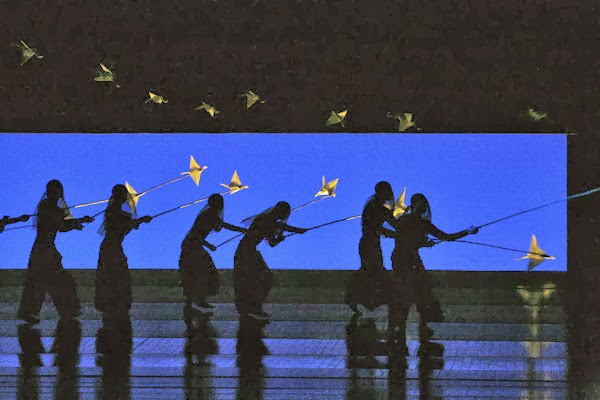 Finally undistracted, I focused on the opera. So much of this production is terrific: the simple set with an angled mirror suspended from above gave the sense that one is peering into a little jewel box. The mirror also served to intensify the colors in the costumes as they reflected out to the audience. And sliding paper walls made Pinkerton’s house delicately and silently move around to make different scenes that were elegant in their minimalism. A single sliver of screen at the back of the stage changed colors, enhancing the mood especially at the end of the second act where Cio-Cio-San waits for Pinkerton to return as day slips into night and her dream of reuniting fades.
Finally undistracted, I focused on the opera. So much of this production is terrific: the simple set with an angled mirror suspended from above gave the sense that one is peering into a little jewel box. The mirror also served to intensify the colors in the costumes as they reflected out to the audience. And sliding paper walls made Pinkerton’s house delicately and silently move around to make different scenes that were elegant in their minimalism. A single sliver of screen at the back of the stage changed colors, enhancing the mood especially at the end of the second act where Cio-Cio-San waits for Pinkerton to return as day slips into night and her dream of reuniting fades.
 The use of puppetry was fantastic. Large white paper birds flapped across the stage at one point. Cio-Cio-San’s son was an amazingly real looking puppet, walking and pointing courtesy of three black clad puppeteers. At times the puppeteers were very obvious, and watching Cio-Cio-San hug the puppet with the three dark puppeteers surrounding her was spooky—it was as though she was surrounded by and hugging the darkness and yet at the same time, not alone with her child but supported by others, albeit perhaps dark forces. Later the puppeteers fade away and the child becomes even more real. Echoes of puppetry occurred throughout the opera as paper butterflies in a long line slowly dropped flew down from the ceiling and then back across the stage. And little red butterflies fell down on the butterfly herself, Cio-Cio-San. The opera swelled with emotion as each element perfectly complemented the others—the music, the colors, the little effects of the butterflies against the simple set.
The use of puppetry was fantastic. Large white paper birds flapped across the stage at one point. Cio-Cio-San’s son was an amazingly real looking puppet, walking and pointing courtesy of three black clad puppeteers. At times the puppeteers were very obvious, and watching Cio-Cio-San hug the puppet with the three dark puppeteers surrounding her was spooky—it was as though she was surrounded by and hugging the darkness and yet at the same time, not alone with her child but supported by others, albeit perhaps dark forces. Later the puppeteers fade away and the child becomes even more real. Echoes of puppetry occurred throughout the opera as paper butterflies in a long line slowly dropped flew down from the ceiling and then back across the stage. And little red butterflies fell down on the butterfly herself, Cio-Cio-San. The opera swelled with emotion as each element perfectly complemented the others—the music, the colors, the little effects of the butterflies against the simple set.The voices were gorgeous too. The singing was solid though I have to say that I was disappointed with Amanda Echalaz as Cio-Cio-San as it sounded like she didn’t take any of her high notes. The audience was left with a more perfunctory Butterfly and one lacking in the emotions the story called for. Echalaz has a strong clear voice, but when I notice the top notes are missing, that’s not good. It was rather conspicuous at points and felt unfinished; there was a rise in emotion, but no real climax or resolution. Such a shame. The terrific Bryan Hymel as Pinkerton has a huge and powerful voice; he was terrific as the coldhearted sailor. Scott Hendricks as Sharpless was the moral compass, emoting empathy and compassion for Cio-Cio-San and frustration with Pinkerton. Elizabeth DuShong, as Suzuki, compensated for Echalaz’s lack of emotion; one could tell she cared for Cio-Cio-San and the child. It was a delight to see newcomer Ryan Speedo Green as The Bonze continue to rise at the Met.
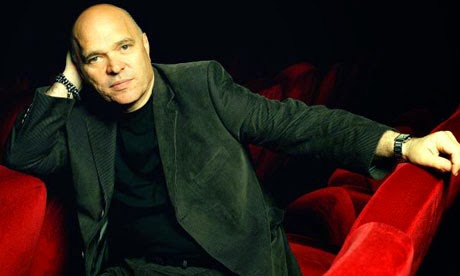 |
| Anthony Minghella |
Shawn – I have been looking forward to seeing this production, since it had its Met debut in 2006. Anthony Minghella is an artist whose work I deeply admire. Truly, Madly, Deeply was the first movie of his that I saw and I ADORE The Talented Mr Ripley. (With the epically great Philip Seymour Hoffman who tragically died Sunday.)
I was not disappointed, except in that the excellence and simplicity of the production made the loss of Minghella, who died in 2008 at age 54, all the more acute to me. I am now able to watch The Talented Mr Ripley without getting a strong feeling of loss, but this Butterfly reactivated those feelings. I now want to see Minghella’s version of every opera, but alas that is not possible. I often wonder what projects he would have produced had he lived.
The simple stage set creates such beauty. Simple sliding paper wall panels in five rows. The back and front lighting for the panels from a row of five suspended side spots is mildly complicated but the whole show has a brilliant simplicity that envelops one as if in a dream.
The production opens with almost several minutes of complete silence as a dancer is wrapped in long red silk ribbons by black clad dancers/stagehands. Such an extended period of complete silence in the cavernous space of the Met is breathtaking; the air thickens, and it is a riveting experience, the coughing and fidgets of the audience aside.
The black clads or Kuroko are the best of their kind I have ever seen in any production anywhere. My first exposure to this kind of stage work must have been in the original John Dexter production of David Henry Hwang’s M. Butterfly on Broadway over 20 years ago, where the Kuroko shifted the sets and tightly and almost invisibly interacted with BD Wong, John Lithgow, and later in the run, Tony Randall.
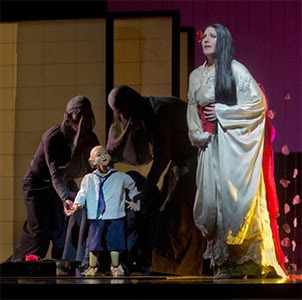 But in this production they are used to even more haunting effect, not only sliding the set panels, but handing off and removing nearly every prop and set piece. Their paper lantern dances are mesmerizing. With their black veils they reminded me of Kendo Players in mourning, death spirits haunting the stage and guiding the action. All appropriate, effective and excellent.
But in this production they are used to even more haunting effect, not only sliding the set panels, but handing off and removing nearly every prop and set piece. Their paper lantern dances are mesmerizing. With their black veils they reminded me of Kendo Players in mourning, death spirits haunting the stage and guiding the action. All appropriate, effective and excellent.The Bunraku puppetry was spectacular. I fell in love with the child puppet. When it was looking at its reflection and playing with the “water,” I completely ceased to see the three black clad puppeteers hunched behind it and bought into the illusion completely. Forget Taymor. This is the way puppetry should be used onstage.
Philippe Auguin and the Met orchestra did ample justice to Puccini’s lush score.
Bryan Hymel, whom we saw in his unexpected Met debut last year in Les Troyens, was excellent and soared as Pinkerton. I very much want to see him do Cavardossi at the Met. God knows the Bondy Tosca needs some new blood (or something) to make it pop.
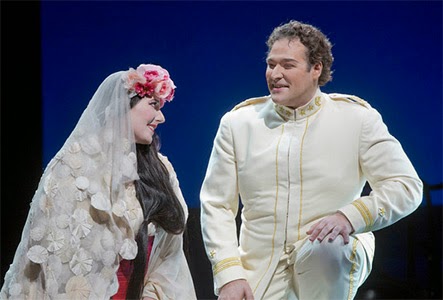 Scott Hendricks as Sharpless I liked very much actually. It can be a nothing role. Elizabeth DuShong, as Suzuki, expressed believable tragedy and loss and was warmly received by the audience and Ryan Speedo Green as The Bonze shined brightly in a small role.
Scott Hendricks as Sharpless I liked very much actually. It can be a nothing role. Elizabeth DuShong, as Suzuki, expressed believable tragedy and loss and was warmly received by the audience and Ryan Speedo Green as The Bonze shined brightly in a small role. Unfortunately, Amanda Echalaz as Cio-Cio-San had problems. Especially up top. Which is pretty problematic in this role needless to say. She had some lovely lines in the middle range stuff, but once things shifted up, the sound, more often than not, did not hold together. But I was too taken with the production to be all that disappointed, though a stronger butterfly would have made for a better evening obviously.
Regardless the production carried the evening for me. I want to see it again as soon as possible and re-experience the exquisite dream tapestry that Minghella has woven.
–Elizabeth Frayer and Shawn E Milnes
Related Links:
Long Night’s Journey Into Gay: Die Fledermaus at the Metropolitan Opera
8 Tips for Having Wild Sex at Your Parent’s House Over the Holidays
Abridged Puppetry and Flashing Birdmen: The Magic Flute at the Metropolitan Opera

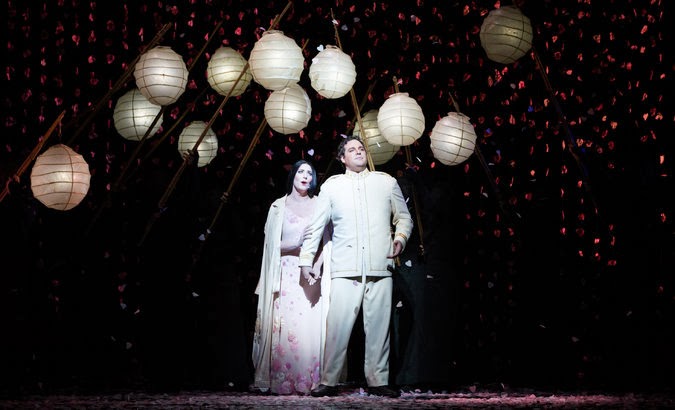
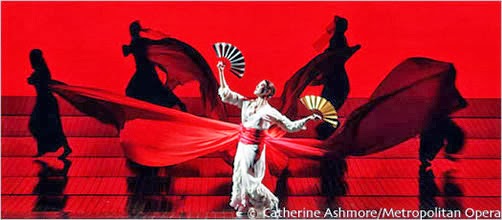


Leave a Reply